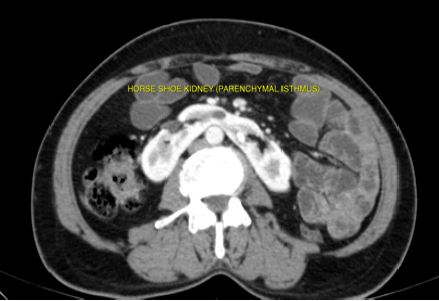Impact Factor : 0.548
- NLM ID: 101723284
- OCoLC: 999826537
- LCCN: 2017202541
*Jayesh Vasudev Trivedi
Received: June 12, 2017; Published: June 26, 2017
Corresponding author: Jayesh V Trivedi, Head of Department and Professor of Medicine, Gujarat Adani Institute of medical science, Bhuj, Gujarat, India
DOI: 10.26717/BJSTR.2017.01.000148
Horse shoe kidney is Ren Arcuatus (Latin word) means renal fusion or super kidney. The incidence is 1 in 600 patients. It is a conginital disorder where both kidneys get fused in the center below inferior mesenteric artery and in front of spine. It is common in men than woman. Fused part of kidney is known as Isthmus. When it occurs in female it is associated with Turners syndrome and its incidence is 15%.It may be associated with left sided inferior venacava.
As it is said that in 90% of patients it is midline symmetrical fusion. Males are affected more. Patients are often asymptomatic and diagnosis is done accidentally during investigation. However renal calculi and chronic urinary tract infections are seen in some cases. Abdominal pains and nausea may be present in some other patients. Renal malignancy and carcinoid tumors are seen at a later age. Many times USG abdomen misses the diagnosis. MRI and DMSA Scan confirm the diagnosis. Other associated congenital conditions are to be rulled out.

Figure 1: Horse Shoe Kidney.
56 yrs male presented with lower abdominal pain. His clinical examination did not show any positive findings. Laboratory investigations were normal. USG examination was normal. CT abdomen showed Horse shoe shaped kidney (Figures 1 & 2). Horseshoe kidney occurs in about 1 in 500 children. It occurs during fetal development as the kidneys move into their normal position. With horseshoe kidney, as [1,2]. Dec 29, 2016 - The horseshoe kidney is the most common type of renal fusion anomaly. It consists of two distinct functioning kidneys on each side of the midline, connected at the lower poles by an isthmus of functioning renal parenchyma or fibrous tissue that crosses the midline of the body [3].

Figure 2: Horse Shoe Kidney (Parenchymal Isthmus).
Dec 29, 2016 - The horseshoe kidney is the most common type of renal fusion anomaly. It consists of two distinct functioning kidneys on each side [4]. Horse shoe kidneys are the most common type of renal fusion anomaly. They render the kidneys susceptible to trauma and are an independent risk factor


